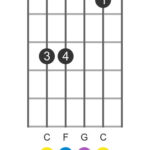Patch cables, also known as pedal cables or pedalboard patch cables, are the unsung heroes of any guitarist’s pedalboard. These small but critical connectors bridge the gap between your effects pedals, ensuring your signal flows smoothly and your tone remains pristine. Whether you’re linking a chain of pedals or creating intricate connections on a larger pedalboard, understanding Guitar Patch Cables is fundamental for every guitarist. They are also useful as “jumper” cables for connecting separate pedalboards or even patching inputs on vintage amplifiers from brands like Marshall and Fender.
Understanding Patch Cable Length and Spacing
Choosing the right length for your guitar patch cables is crucial for maintaining a tidy and efficient pedalboard layout. The primary goal is to minimize excess cable, keeping your pedals closely spaced and your signal path clean.
- Typical Lengths: While custom lengths are available, common patch cable lengths often range from 4 inches upwards. The 6-inch patch cable is a popular choice, offering a versatile balance between compactness and reach for connecting pedals in various configurations. For thicker, higher-quality cables, like our Pro Patch, a minimum length of 8 inches might be necessary due to cable diameter and connector size.
Exploring Different Patch Cable Types and Plugs
The connectors at the ends of your guitar patch cables play a significant role in pedalboard ergonomics. Different plug configurations are designed to accommodate various pedal jack layouts and spacing constraints.
-
Plug Configurations:
- U-Config: Features plugs oriented in the same direction, ideal for connecting pedals with side-by-side input/output jacks. This configuration allows for a very tight and neat arrangement of pedals.
- S-Config: Plugs face opposite directions, perfect for connecting a pedal with side jacks to one with top-mounted jacks. This design helps manage space when pedals have differing jack positions.
-
Plug Types:
- Pancake Plugs: Known for their low profile, pancake plugs are excellent for maximizing space, especially when pedals are placed very close together. However, not all pancake plugs are created equal. Look for robust designs like the Rattlesnake RCC Star Pancakes, which utilize a dual-lug system for enhanced reliability and durability compared to standard pancake-style plugs.
- Right Angle Plugs: These plugs offer a 90-degree angle, often used for connecting pedals in tighter spaces or at the edges of a pedalboard. High-quality right-angle plugs, such as Rattlesnake RCC Right Angle (GGN Plugs Gold/Gold/Nickel), ensure excellent signal transfer and durability.
- Straight Plugs: Straight plugs are suitable when space isn’t a major constraint and can sometimes be preferred for their straightforward connection. Stubby straight plugs, like G&H Stubby Straight plugs, are particularly useful when connecting to loop switchers or patch bays where jacks are closely spaced.
Choosing the Best Guitar Patch Cables for Your Pedalboard
When it comes to selecting the “best” guitar patch cables, quality and reliability are paramount. Your patch cables are integral to your signal chain, and skimping on quality here can negatively impact your tone and performance.
- Quality Components and Construction: Opt for patch cables that are hand-soldered and made with high-quality components. This ensures a strong, reliable connection and optimal signal flow.
- Rattlesnake Cables Patch Options:
- Flex Patch Cables: Offer a balance of quality and flexibility. These cables use a smaller diameter cable and spiral copper shield, providing greater flexibility while maintaining good signal integrity.
- Pro Patch Cables: Represent the highest level of quality. Utilizing the same cable as our Standard and Snake Head instrument cables, Pro Patch cables deliver exceptional signal clarity and durability. Ideal for discerning players who demand the best possible performance.
Made in the USA: Quality You Can Trust
Both our Flex Patch and Pro Patch cables are manufactured with pride in the USA. The cable itself is made to our custom specifications, and each cable is hand-assembled in Missoula, Montana. Choosing US-made cables often translates to higher quality control and materials, providing peace of mind and reliable performance for your pedalboard.
In conclusion, guitar patch cables are more than just wires; they are vital components that directly impact your guitar tone and pedalboard functionality. By understanding the different types, lengths, and quality considerations, you can make informed decisions to optimize your pedalboard setup and ensure your signal travels flawlessly. Explore the range of options available and invest in quality patch cables to unlock the full potential of your pedalboard.


